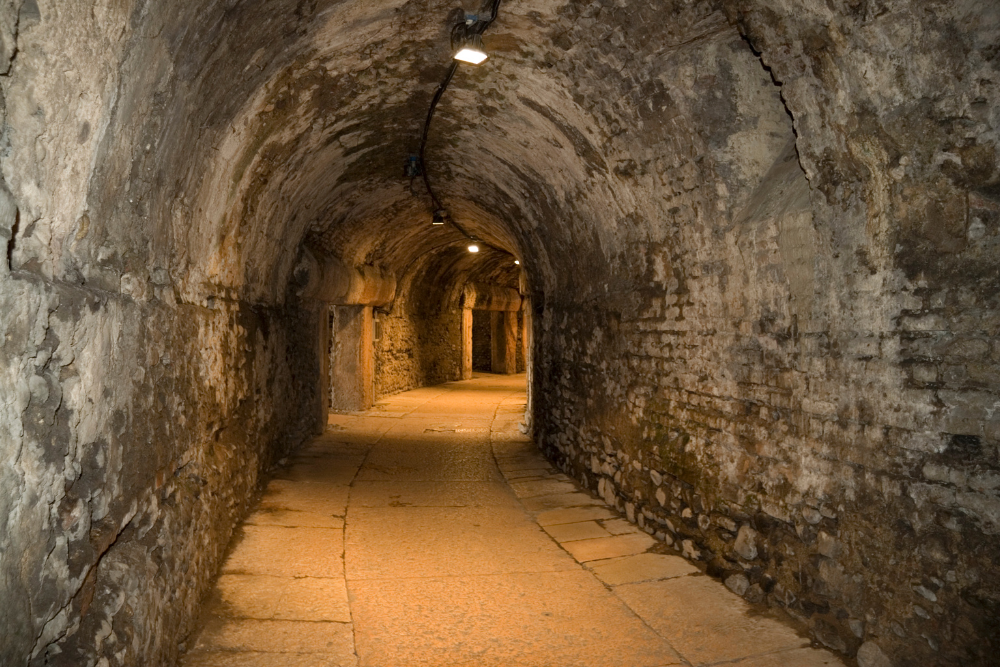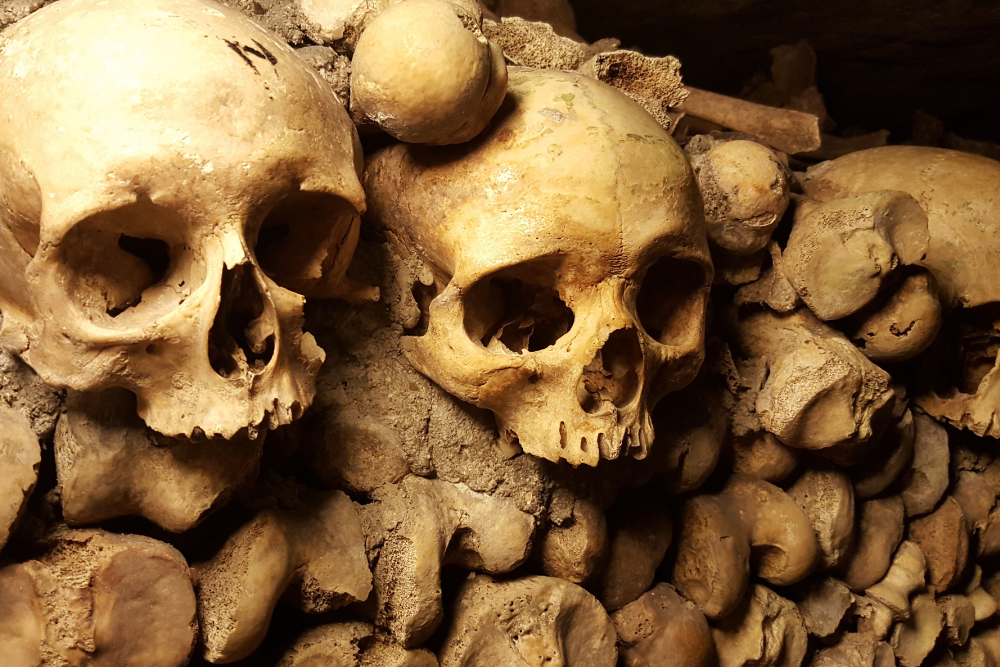Beneath the bustling streets of Paris, hidden in the dark, labyrinthine tunnels, lies a macabre yet fascinating site: the Catacombs of Paris. This eerie network of underground ossuaries, housing the remains of over six million Parisians, offers an extraordinary glimpse into the city’s rich history, its evolution, and the mysteries that have lurked beneath its surface for centuries.
The Catacombs have long intrigued travelers, history enthusiasts, and those with a curiosity for the strange and unusual. These subterranean tombs are not just a collection of bones; they are an essential part of Paris’s heritage, steeped in mystery, tragedy, and stories of life and death that shaped the city as we know it today. Whether you’re a history buff, an adventure seeker, or simply someone looking for a unique experience, exploring the Catacombs is an unforgettable journey into the past.
In this blog, we’ll unveil the secrets of the Catacombs of Paris, exploring their origins, significance, and the eerie beauty that has made them one of the most visited and fascinating historical sites in the world.
1. The Origins of the Catacombs: A Tale of Bones and Burials
The story of the Catacombs begins in the late 18th century, when Paris faced a severe public health crisis. At the time, the city’s cemeteries, particularly the Les Innocents Cemetery, had become overcrowded. The lack of proper burial space led to unsanitary conditions, with decomposing bodies leaking into nearby homes and streets. To address this growing health issue, the French government decided to move the remains from the city’s cemeteries to a more suitable and controlled location.
In 1786, the authorities began the monumental task of transferring the remains to the old limestone quarries located beneath the city. These quarries had been excavated for centuries and had left behind a vast network of tunnels that were largely abandoned. The authorities saw this as a perfect solution, using the catacombs as a place to store the remains of thousands of people.
The remains were carefully arranged in the quarries, creating a vast and eerie underground ossuary. Over time, additional cemeteries were emptied, and the Catacombs continued to expand. By the early 19th century, the Catacombs had become a final resting place for millions of Parisians, a dark and haunting testament to the city’s history and its struggles with death.
2. A Mysterious and Eerie Atmosphere
When you descend into the Catacombs today, you’re immediately struck by the sheer scale of the underground network and the strange, almost otherworldly atmosphere. The narrow, dimly lit tunnels stretch for over 300 kilometers beneath Paris, but only a small portion of them is open to the public. Visitors can explore around 1.7 kilometers of these ancient tunnels, where the walls are lined with bones—skulls and femurs arranged in intricate patterns, creating an almost artistic display of death.
The Catacombs are not just an ossuary; they are a monument to the dead, crafted with a certain reverence and care by those who managed the site. The bones are carefully arranged, stacked neatly, and sometimes even arranged in decorative patterns. The effect is both beautiful and unsettling, evoking a sense of awe and reverence for the lives that once were.
The haunting silence of the Catacombs, broken only by the soft echo of footsteps, adds to the eerie atmosphere. The air is cool and damp, with a musty, earthy scent that fills your nostrils as you explore the dark corridors. The quiet solemnity of the place, combined with the stark reminder of death all around, gives the Catacombs an otherworldly charm that captivates all who visit.
3. The History and Symbolism of the Catacombs
The Catacombs are not merely a burial site; they are also a reflection of the changing attitudes towards death in Paris during the 18th and 19th centuries. When the remains of the dead were first moved to the catacombs, they were placed in a somewhat disorganized manner. However, as time passed, the bones were carefully arranged, and decorative features were added, such as the famous inscription that greets visitors upon entry: “Arrête! C’est ici l’empire de la mort.” (Stop! This is the empire of death.)
The symbols used in the Catacombs are significant. Many of the displays of bones are arranged in shapes that reflect classical and Christian symbolism, such as crosses, wreaths, and other religious motifs. This was a deliberate choice, reflecting the reverence and respect the people of Paris held for the dead. In a way, the Catacombs serve as a unique art gallery of the macabre, combining the physical remains of the deceased with symbolic representations of the afterlife.
Additionally, the Catacombs have long been associated with secrecy and mystery. Over the years, various underground societies, such as the Freemasons and secret revolutionary groups, were rumored to have used the tunnels for clandestine meetings and activities. The idea of a hidden world beneath Paris filled with untold secrets has only added to the allure and mystique of the Catacombs.
4. Not Just Bones: What Else Lies Beneath
While the Catacombs are primarily known for their bones, there’s much more to see and learn beneath the surface. The tunnels themselves are a fascinating feat of engineering. Carved out of the soft limestone that underlies much of Paris, the quarries are expansive and intricate, forming a network of corridors that seem to stretch on endlessly.
In some sections of the Catacombs, visitors can view remnants of ancient quarrying tools and the stone-cutting process that created the tunnels. There are also various crypts and small chapels that were built in the early years of the Catacombs’ use as an ossuary. These small chapels were once used by the workers and clergy who tended to the dead, and they provide an insight into the religious practices of the time.
One of the more intriguing features of the Catacombs is the wall of inscriptions, where visitors have left messages over the years, some in the form of graffiti, others as personal remembrances to the dead. These inscriptions are reminders of the human presence within the Catacombs and of the continued reverence for the place, even long after its original purpose was fulfilled.
5. How to Visit the Catacombs: Tips for Exploring
The Catacombs of Paris are one of the city’s most unique and haunting attractions, and visiting them is a must for any adventurous traveler. Here’s everything you need to know to make the most of your experience:
– Plan Ahead: The Catacombs are a popular tourist destination, so it’s best to book tickets in advance, especially during peak tourist seasons. Tickets can be purchased online, and there’s often a line for entry.
– Wear Comfortable Shoes: The Catacombs involve a fair amount of walking, and the floors can be uneven. Make sure you wear comfortable, sturdy shoes, as the path can be slippery and the tunnels can be narrow and winding.
– Expect Cold Temperatures: The temperature in the Catacombs remains a cool 14°C (57°F) year-round, so dress appropriately. A light jacket is recommended, especially if you’re visiting during the colder months.
– Guided Tours: To gain a deeper understanding of the history and significance of the Catacombs, consider taking a guided tour. Knowledgeable guides can offer fascinating insights into the history, symbolism, and mysteries of this underground world.
– Respect the Place: The Catacombs are a sacred and somber site. It’s important to approach your visit with respect and reverence for the remains of the people interred there. Remember, the Catacombs are not just a tourist attraction but also a reminder of the lives that once were.
6. The Mystique and Legacy of the Catacombs
The Catacombs of Paris are a striking symbol of the delicate balance between life and death, and they remind us of the fragile nature of human existence. As you wander through the tunnels, surrounded by the bones of millions, you can’t help but feel a deep connection to the past—a past where death was ever-present and where the boundaries between the living and the dead were often blurred.
Though often considered a macabre or eerie place, the Catacombs are a testament to the resilience of Paris and its people. They serve as a monument to the dead, a space where memory, history, and art converge in a truly unique setting. The Catacombs remind us of the complex relationship we have with mortality, and in doing so, they hold a deep, eternal fascination.
If you’re looking for a truly unique and thought-provoking experience in Paris, exploring the Catacombs of Paris is an absolute must. With their history, eerie beauty, and hidden secrets, they offer a chilling yet captivating journey beneath the streets of one of the world’s most vibrant cities.












